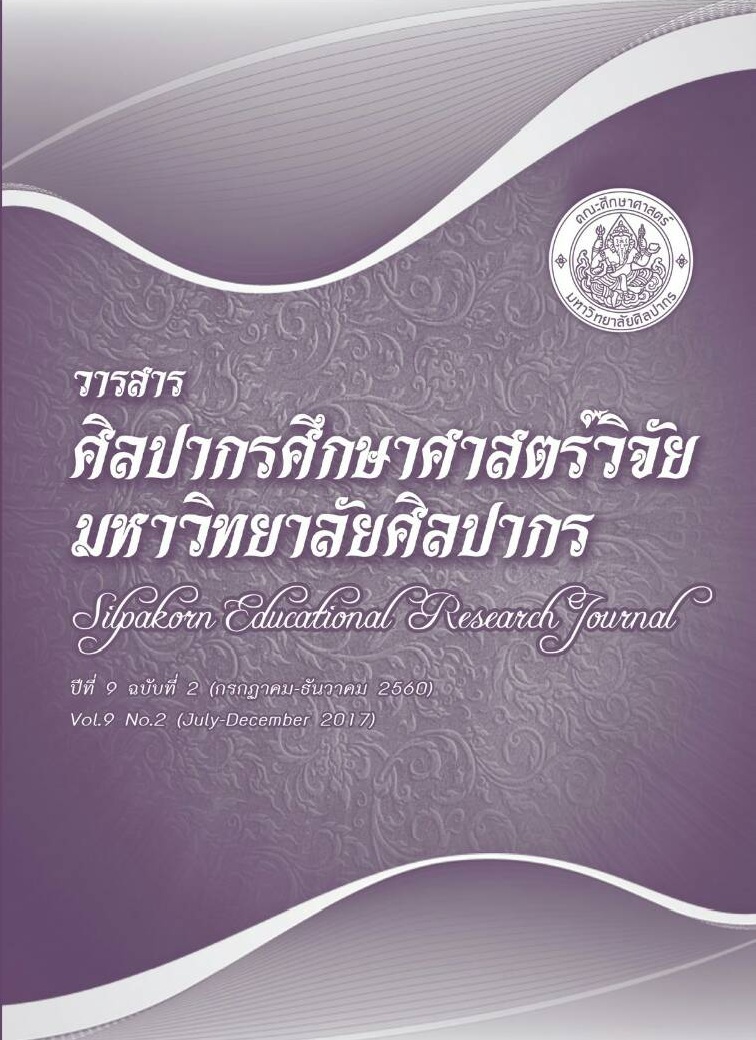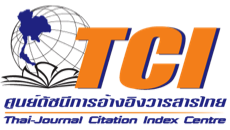การพัฒนารูปแบบการจัดการเรียนรู้วิทยาศาสตร์โดยใช้โครงงานร่วมกับเทคนิคการสืบเสาะหาความรู้ ตามแนวคิดห้องเรียนกลับด้าน เพื่อเสริมสร้างความสามารถในการสร้างนวัตกรรมและจิตวิทยาศาสตร์ของนักเรียนระดับชั้นมัธยมศึกษาปีที่ 3 (The Development of Instructional Science Model by using Project-based Learning Through Inquiry-based Learning by Flipped Classroom Approach to Enhance Creative Innovation Ability and Scientific Minds on Ninth Grade Students)
คำสำคัญ:
รูปแบบการจัดการเรียนรู้วิทยาศาสตร์/การจัดการเรียนรู้โดยใช้โครงงาน/เทคนิคการสืบเสาะหาความรู้/แนวคิดห้องเรียนกลับด้าน/ผลสัมฤทธิ์ทางการเรียน/นวัตกรรม/จิตวิทยาศาสตร์บทคัดย่อ
การพัฒนารูปแบบการจัดการเรียนรู้วิทยาศาสตร์โดยใช้โครงงานร่วมกับเทคนิคการสืบเสาะหาความรู้ ตามแนวคิดห้องเรียนกลับด้าน เพื่อเสริมสร้างความสามารถในการสร้างนวัตกรรมและจิตวิทยาศาสตร์ของนักเรียนระดับชั้นมัธยมศึกษาปีที่ 3
The development of instructional science model by using project-based learning through inquiry-based learning by flipped classroom approach to enhance creative innovation ability and scientific minds on ninth grade students
บทคัดย่อ
การวิจัยมีวัตถุประสงค์เพื่อ 1.พัฒนาและหาประสิทธิภาพของรูปแบบการจัดการเรียนรู้วิทยาศาสตร์โดยใช้โครงงานร่วมกับเทคนิคการสืบเสาะหาความรู้ ตามแนวคิดห้องเรียนกลับด้าน และ2.ประเมินประสิทธิผลของรูปแบบ กลุ่มตัวอย่าง คือนักเรียนชั้นมัธยมศึกษาปีที่ 3/1 ภาคเรียนที่ 2 ปีการศึกษา 2558โรงเรียนรัตนราษฎร์บำรุง จำนวน 39 คน เครื่องมือที่ใช้ในการวิจัยประกอบด้วย รูปแบบการจัดการเรียนรู้วิทยาศาสตร์โดยใช้โครงงานร่วมกับเทคนิคการสืบเสาะหาความรู้
ตามแนวคิดห้องเรียนกลับด้าน คู่มือการใช้รูปแบบ หน่วยและแผนการจัดการเรียนรู้ แบบประเมินผลสัมฤทธิ์ทางการเรียนวิทยาศาสตร์ แบบประเมินความสามารถในการสร้างนวัตกรรม แบบประเมินจิตวิทยาศาสตร์ และแบบสอบถามความคิดเห็น วิเคราะห์ข้อมูลโดย S.D. ค่าทีแบบไม่อิสระและการวิเคราะห์เนื้อหา ผลการวิจัย พบว่า1.รูปแบบ “SCIENCE Model” มี 5 องค์ประกอบ ได้แก่ หลักการ วัตถุประสงค์ กระบวนการจัดการเรียนรู้(1.กระตุ้นผู้เรียน 2.พิจารณาสาเหตุ 3.สืบเสาะแสวงหา 4.สำรวจและตรวจสอบ 5.บันทึกและอภิปราย 6.สรุปและขยายความรู้) การวัดและประเมินผล และเงื่อนไขสำคัญในการนำรูปแบบไปใช้ให้ประสบผลสำเร็จ รูปแบบนี้มีประสิทธิภาพ 80.00/80.21 2.ประสิทธิผลของรูปแบบพบว่านักเรียนมี 1) ผลสัมฤทธิ์ทางการเรียนวิทยาศาสตร์หลังใช้รูปแบบสูงกว่าก่อนใช้รูปแบบอย่างมีนัยสำคัญทางสถิติที่ระดับ .05 2) ความสามารถในการสร้างนวัตกรรมระดับดี 3) จิตวิทยาศาสตร์ระดับมากที่สุด และ4) ความคิดเห็นต่อการใช้รูปแบบมีความรู้ร่วมกับพัฒนาจิตวิทยาศาสตร์และสื่อใช้ได้ทุกที่ทุกเวลา
Abstract
The purposes of this research were to: 1) develop and determine the efficiency of instructional science model by using project-based learning through inquiry-based learning by flipped classroom approach. 2) evaluate the effectiveness of instructional science model. The samples comprised 39 9th grade students during the second semester of the academic year 2015 at Ratanaratbumrung school. Research instruments consisted of instructional science model by using project-based learning through inquiry-based learning by flipped classroom approach, a handbook for the model, units and lesson plans, learning outcome test form “Astrophysics and Space”, creative innovation ability assessment forms, science scientific minds assessment forms and opinion questionnaire in science model. The data was analyzed by mean, standard deviation, a dependent t-test and content analysis.
The results were as follows:
1. The instructional science model called “SCIENCE Model” consisted of five elements; principle, objective, learning process which had six steps;(1.Stimulation:S 2.Consideration and Cause:S 3.Inquiry:I 4.Exploration and Examine:E 5.Note and Discussion:N and6.Conclusion and Elaboration:CE), assessments and evaluations, and the important conditions for using the model successfully and efficiency of this model was 80.00/80.21 2.The effectiveness after using the SCIENCE Model indicated that 1) learning outcome test higher than before .05 significance, 2) the students’ creative innovation in level good, 3) the students learning styles had a best of high level of scientific minds. and 4) the students opinions toward steps the learning encourage with knowledge coupled with the development scientific minds and medias can be accessed anytime, anywhere.





